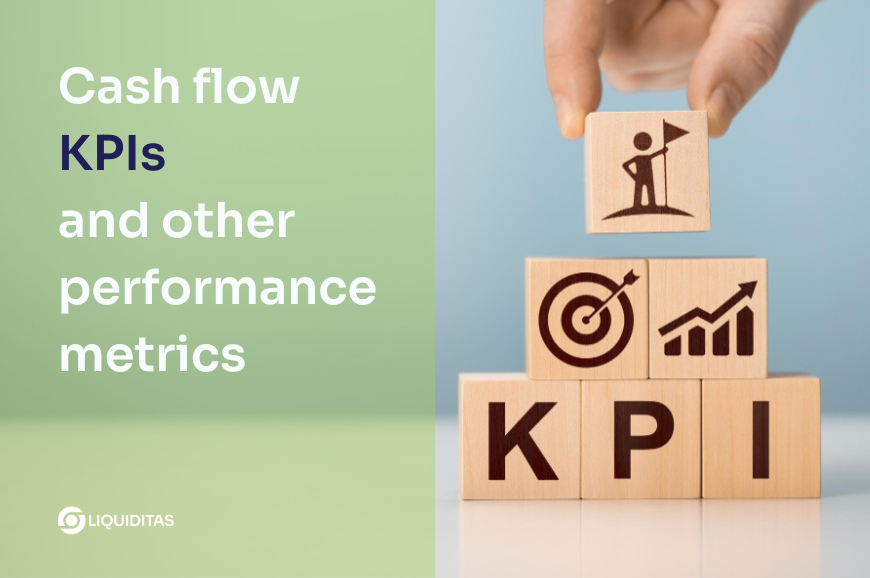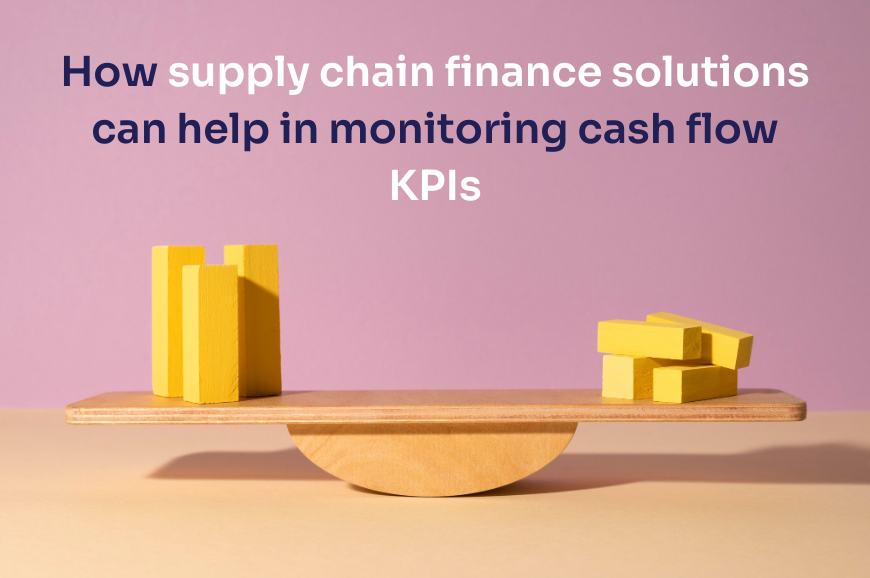
Cash flow Key Performance Indicators or KPIs are financial metrics used to assess the efficiency and health of a company’s cash flow.
These indicators provide crucial insights into money movement within an organisation over a specific period, offering a clear picture of its financial viability and operational strength.
A successful and efficient business operation depends on cash flow management since it fosters resilience and growth.
Analysing these KPIs helps businesses make informed decisions about managing cash flow, optimising operations, and ensuring financial stability.
With the help of these metrics, companies can easily have a more controllable environment where cash flow can be carefully used for planning, reducing costs and overall debt, and reallocating funds in order to invest in potential lucrative segments.
The most directly influenced role in the company as well as the one that needs to have full control over the KPIs is the Chief financial officer or CFO.
KPIs are a valuable asset for CFOs because they bring them the vision, they desperately need in order to make more informed decisions. Simply put, KPIs provide the answer to where to cut off, and where to add in, all in order for CFOs to better use their balance sheet.
Essential cash flow KPIs
Although there are many cash flow KPIs, the most important ones that we will cover here are operating cash flow (OCF), free cash flow (FCF), and cash conversion cycle (CCC).
Operating Cash Flow
Operating Cash Flow (OCF) is a fundamental financial metric that measures the cash generated or used by a company’s core operating activities within a specific period. This KPI indicates a business’s ability to generate enough cash from its primary operations to maintain and grow its overall workflow.
Significance of OCF
Financial Health: OCF reflects the company’s power to generate cash from its core operations, indicating its financial health is independent of financing and investing activities.
Sustainability: It showcases whether a company can sustain its operations and investments without relying on external financing.
Investment Potential: CFOs use OCF to evaluate a company’s ability to generate cash and fund future investments.
Operational Efficiency: Monitoring changes in OCF over time helps in assessing the efficiency of a company.
Calculation
The formula used to calculate OCF KPI is:
OCF = Net Income + Non−Cash Expenses (Depreciation,Amortisation,etc.) + Changes in Working Capital
Interpretation
Positive OCF: Indicates that the company generates more cash than it spends. It suggests financial stability and potential for growth.
Negative OCF: Suggests that the company is not generating sufficient cash to sustain its business activities without external financing. This could signal financial strain or inefficiency.
Comparison Over Time or Industry Benchmarks: Analysing OCF trends over time or against industry benchmarks helps in assessing the company’s performance and identifying areas that need improvement.
Free Cash Flow (FCF)
Free Cash Flow (FCF) represents the cash a company generates after accounting for expenditures necessary to maintain or expand its asset base. It’s a crucial metric among the cash flow KPIs used to evaluate a company’s financial health and its ability to generate surplus cash for potential distributions to shareholders, debt repayment, or reinvestment in the business.
Significance of FCF
Financial Health Assessment: FCF offers insights into the actual cash generated by a company’s core operations after accounting for capital expenditures required to maintain its business.
Investment Potential: CFOs or investors often use FCF to assess the company’s capacity to invest in new projects, pay dividends, or reduce debt.
Strategic Planning: It aids in strategic decision-making by indicating available funds for growth, acquisitions, or R&D activities.
Shareholder Value: FCF is often linked to shareholder value creation, as it can be used for dividends, share buybacks, or reinvestment for future growth.
Calculation
The formula to calculate FCF is typically:
FCF = Operating Cash Flow – Capital Expenditures
Interpretation
Positive FCF: Indicates that a company generates more cash from its operations than it invests in maintaining or expanding its asset base. It signifies financial strength, potential for growth, and capacity to reward shareholders.
Negative FCF: Implies that the company is spending more on capital expenditures than it generates from its operations. This might suggest potential issues with liquidity, ability to grow, or need for external financing.
Cash Conversion Cycle (CCC)
The Cash Conversion Cycle (CCC) is a financial metric that measures the time it takes for a company to convert its investments in inventory into cash through sales. This cash flow KPI evaluates the efficiency of a company’s management of working capital and operational effectiveness.
The CCC is calculated by combining three key components:
Days Inventory Outstanding (DIO): This metric shows the average period it takes for a company to sell its inventory.
It shows the efficiency of a certain company to manage its inventory. Lower DIO indicates better inventory management.
Days Sales Outstanding (DSO): This measures the average number of days it takes for a company to collect payment after a sale.
Days Payable Outstanding (DPO): This represents the average number of days a company takes to pay its suppliers.
The Cash Conversion Cycle formula combines these three components:
CCC = DIO + DSO – DPO
Interpretation
Unlike other KPIs, the CCC provides insights into how efficiently a company manages its cash flow and working capital. A shorter CCC typically indicates that the company efficiently turns its resources into cash, improving liquidity and financial health. Conversely, a longer CCC suggests potential inefficiencies in inventory management, collections, or payment processes, impacting cash flow and operational effectiveness. Efficient management of the CCC is essential for optimising working capital and sustaining a healthy cash flow position.
Performance metrics linked to cash flow

Days Sales Outstanding (DSO)
Days Sales Outstanding (DSO) is a metric that showcases the average number of days it takes for a company to collect payment after a sale has been made. It’s a crucial indicator of a company’s efficiency in collecting receivables from its customers.
The formula to calculate DSO is:
DSO = Accounts Receivable × Number of Days / Total Credit Sales
Breakdown of components
Accounts Receivable: The total amount of money owed to a company by its customers for goods or services sold on credit.
Number of Days: A specific period for which the calculation is made, usually monthly, quarterly, or annually.
Total Credit Sales: The total sales made on credit during that period.
DSO is essential for understanding how efficiently a company manages its accounts receivable.
Interpretation
Low DSO: showcases that the company is collecting payments efficiently. It means customers are paying their bills relatively quickly, which can be a positive sign of strong cash flow, efficient credit management, and effective collections processes. A low DSO often suggests that a company has a healthy financial position and liquidity, as it can convert sales into cash rapidly.
High DSO: suggests that a company takes longer to collect payments from its customers. This could indicate potential issues with cash flow management, such as slow-paying customers, ineffective credit policies, or difficulties in collections. A high DSO may lead to cash flow constraints, impacting the company’s ability to meet short-term obligations or invest in growth opportunities.
Days Payable Outstanding
Days Payable Outstanding (DPO) is a financial metric that measures the average number of days a company takes to pay its suppliers or vendors for goods or services received on credit. It indicates how long a company typically takes to settle its accounts payable.
The formula to calculate DPO is:
DPO = Accounts Payable × Number of Days / Total Cost of Goods Sold
Breakdown of components
Accounts Payable: The total amount of money owed by a company to its suppliers or vendors for goods or services received on credit.
Number of Days: A specific period for which the calculation is made, typically monthly, quarterly, or annually.
Total Cost of Goods Sold (COGS): The total cost incurred by a company to produce or purchase the goods sold during that period.
Interpretation
DPO is crucial for understanding how efficiently a company manages its accounts payable. A higher DPO indicates that a company takes longer to pay its suppliers, which can positively impact cash flow and working capital management. A longer DPO means the company can hold onto cash for a longer period before paying its obligations, providing more flexibility to invest in other areas of the business or cover unforeseen expenses.
However, an excessively high DPO could also indicate that a company is stretching its payment terms too far, potentially damaging relationships with suppliers if it leads to late payments or strained supplier relations.
Interpreting DPO involves considering industry standards and benchmarks. DPO can vary across industries due to different payment terms and supplier relationships. Analyzing a company’s DPO against competitors or industry averages might reveal information about how well it manages accounts payable and how it handles payments.
Days Inventory Outstanding (DIO)
Days Inventory Outstanding (DIO) is a financial instrument that determines how long it typically takes a business to convert its inventory into sales. It shows insight into how efficiently a company manages its inventory by determining the number of days it holds inventory before selling it.
The formula to calculate DIO is:
DIO = Average Inventory × Number of Days / Cost of Goods Sold
Breakdown of components
Average Inventory: The average value of inventory held by a company during a specific period, usually calculated as the average of beginning and ending inventory for the period.
Number of Days: A specific period for which the calculation is made, often monthly, quarterly, or annually.
Cost of Goods Sold (COGS): The total cost incurred by a company to produce or purchase the goods sold during that period.
DIO is essential for evaluating inventory management efficiency. A lower DIO indicates that a company is efficiently selling its inventory, converting it into sales within a shorter period. This efficiency can positively impact cash flow by reducing holding costs, minimising the risk of obsolete inventory, and freeing up cash that would otherwise be tied up in stock.
Conversely, a higher DIO suggests that a company takes longer to sell its inventory, which could indicate overstocking, slow-moving inventory, or inefficiencies in the sales process. This could tie up more working capital and potentially lead to increased storage costs and markdowns on unsold goods, negatively affecting cash flow.
Working Capital Ratio
The Working Capital Ratio, also known as the Current Ratio, measures a company’s ability to cover its short-term liabilities with its short-term assets. It is calculated by using the current formula:
Working Capital Ratio = Current Assets / Current Liabilities
Breakdown of components
Current Assets: Assets that are expected to be converted into cash or used up within one year, including cash, accounts receivable, inventory, and other short-term assets.
Current Liabilities: Obligations and debts due within one year, such as accounts payable, short-term loans, and accrued expenses.
Interpretation
The Working Capital Ratio provides insight into a company’s liquidity and short-term financial health. A ratio above 1 indicates that a company has more current assets than current liabilities, suggesting it has enough short-term assets to cover its immediate obligations. However, a ratio significantly higher than 1 might indicate an excessive buildup of current assets, potentially signaling underutilised resources.
Correlation with cash flow
The correlation between the Working Capital Ratio and cash flow lies in the management of current assets and liabilities. Effective management of working capital can positively impact cash flow in the following ways:
Optimising Inventory Levels: Efficient inventory management can reduce holding costs and free up cash tied up in excess inventory.
Streamlining Accounts Receivable: Accelerating the collection of accounts receivable can improve cash flow by converting outstanding invoices into cash faster.
Managing Accounts Payable: Extending payment terms with suppliers without harming relationships can provide more time to use cash for other purposes before settling liabilities.
Negotiating Better Terms: Negotiating favourable terms with both suppliers and customers can optimise the cash conversion cycle.
How supply chain solutions can help in monitoring cash flow KPIs

Supply chain finance solutions can play a crucial role in measuring and monitoring KPIs within a company’s operations.
For example, by offering early payment options or optimising payment terms, supply chain finance solutions can positively impact cash flow metrics. This directly affects KPIs related to working capital turnover, days payable outstanding (DPO), and cash conversion cycle.
Moreover, these solutions often provide real-time data and analytics, offering better visibility into the financial aspects of the supply chain. This visibility aids in monitoring KPIs related to inventory turnover, supplier performance, and order-to-delivery cycle times.
In essence, supply chain finance solutions not only streamline financial processes but also provide valuable data that can be used to measure, monitor, and optimise various KPIs critical to a company’s success in managing its supply chain operations.
Establishing a regular review process for cash flow KPI analysis
Establishing a structured and consistent KPI review process is pivotal in driving organisational success. This entails defining clear objectives, selecting relevant KPIs, and setting a regular cadence for analysis. By implementing a routine review, be it weekly, monthly, or quarterly, teams can track progress, identify trends, and make informed decisions to pivot strategies if needed. This continuous evaluation not only ensures alignment with business goals but also fosters a culture of adaptability and responsiveness, ultimately fueling ongoing improvement and success.

